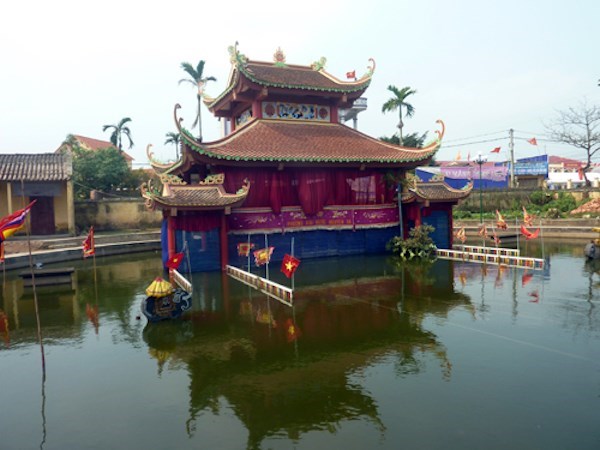
Vietnam has announced eight additional national intangible cultural heritages under the Decision No.3325/DD-BVHTTDL, recently signed by Minister of Culture, Sports, and Tourism Nguyen Ngoc Thien.

A venue for water puppetry (Source: VNA)
They include papermaking by the Dao Do ethnic people in Viet Quang
town, Bac Quang district, the northern province of Ha Giang; Dum singing in the
communes of Phuc Le, Pha Le, Lap Le, Tam Hung, and Ngu Lao in Thuy Nguyen
district, the northern city of Hai Phong; Qua Son temple festival in Boi Son
commune, of Do Luong district, the central province of Nghe An; as well as Lang
Son temple festival in Trung Nghia commune, Thanh Thuy district, the northern
province of Phu Tho.
Others consist of the coming of age worship ritual by the Ede ethnic group in
Song Hinh commune, in Son Hoa district, the central province of Phu Yen; Linh
Son Thanh Mau (Mother Goddess of the Mountain) festival in the southern
province of Tay Ninh; water puppetry in Nguyen Xa and Dong Cac communes, in
Dong Hung district, the northern province of Thai Binh; as well as the
traditional bronze casting of Che village in Thieu Trung commune,in Thieu Hoa
district, the central province of Thanh Hoa.
Under the decision, the chairpersons of People’s Committees of localities,
where the new national intangible cultural heritages were recognised, were
required to manage them well in line with the law.
As of September 2018, Vietnam boasted nearly 260 national intangible cultural
heritages.
Source: VNA
With an increasingly vibrant and widespread emulation movement aimed at building cultured residential areas and cultured families, Yen Thuy District has been making steady progress toward improving both the material and spiritual well-being of its people, while fostering a civilized, prosperous, beautiful, and progressive community.
Once lacking recreational spaces and community facilities, Residential Group 2 in Quynh Lam Ward (Hoa Binh City) has recently received attention for the construction of a new, spacious, and fully equipped cultural house. The project followed the model of state support combined with public contributions in both labor and funding.
The "All people unite to build cultural life" movement, which has been effectively integrated with Kim Boi district’s socio-economic development goals, is fostering a lively spirit of emulation across local residential areas, hamlets, villages, public agencies, and enterprises. In addition, through the initiative, traditional cultural values are being preserved and promoted, while community solidarity and mutual support in poverty reduction and economic development are being strengthened.
A working delegation of the Hoa Binh provincial People’s Committee led by its Permanent Vice Chairman Nguyen Van Toan on June 11 inspected the progress of a project to build the Mo Muong Cultural Heritage Conservation Space linked to tourism services in Hop Phong commune, Cao Phong district.
Born and growing in the heroic land of Muong Dong, Dinh Thi Kieu Dung, a resident in Bo town of Kim Boi district, in her childhood was nurtured by the sweet lullabies of her grandmother and mother. These melodies deeply imprinted on her soul, becoming an inseparable part of her love for her ethnic group's culture. For over 20 years, this love for her hometown has driven Dung to research, collect, and pass down the cultural values of the Muong people to future generations.
In the final days of May, the Ethnic Art Troupe of Hoa Binh Province organized performances to serve the people in remote, mountainous, and particularly disadvantaged areas within the province. These were not just ordinary artistic shows, but they were the meaningful journeys aimed at spreading cultural values, enhancing the spiritual life of the people and contributing to the preservation of ethnic minority cultural identities.



